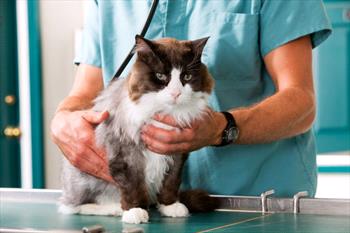Frequently in our jobs at veterinary hospitals, shelters or even boarding facilities, we’re so used to dealing with animals and trying to get our jobs done quickly that we forget how our actions can affect the animal or look to the clients. For instance, Cindy Dean describes two different types of encounters she has had when she takes her dogs to the veterinary hospital she’s been going to for 20 years.
“Some of the vets that our dogs have seen do not seem to know how to approach a shy dog,” says Dean. These veterinarians have had trouble examining the dog and have had Dean open the mouth to examine at a distance.
Dean continues, “In general, these vets haven’t taken the time to make him feel comfortable with them or to try to get to know him and would try to “force” him to get his shots and nails done. It was not a pleasant experience for him.”
Luckily for Dean, this is not the case for all of the veterinarians at the hospital. She states, “We’ve found a couple of vets there who are ‘animal savvy’ and take their time approaching, giving treats and letting him smell them. They’ve improved even more after attending a half-day Low Stress Handling® Seminar. With the training, they now handle our dog even better, to the point where he is comfortable and friendly with them and allows them to do whatever they need to do—look at his teeth/gums, etc. They were able to give him a full physical without any struggle.” Dean also clarified, “I haven’t seen the other veterinarians since they went through the Low Stress Handling® Training so I don’t know whether they have improved.”
Download the free poster How to Handle Patients in a Caring Manner, one of Dr. Sophia Yin’s Essential Low Stress Handling® Posters available for free or donation
While most veterinarians and petcare professionals want to help animals, sometimes even when we are trying to be helpful and friendly, we inadvertently do things that make the animal more uncomfortable or scared, which in turn makes each interaction more laborious and even unsafe. It may seem that some people just have a gift for knowing how to act around animals and others lack it; however, the difference is really about whether they can understand the animal’s point of view. In reality dogs and cats are a lot like us humans. The same things that make them uncomfortable would make us nervous too. Here are five tips that will help you.
Tip 1: Handle cooperatively rather than forcefully. We wouldn’t want our children handled forcefully for a medical examination. Animals don’t like to be man-handled either. Such handling can establish negative relationships, which can quickly lead to resistance and defensive behavior by the pet. It’s best to learn more cooperative ways for handling pets (and people too!).
Tip 2: Greet your patient first. It’s disconcerting when a medical professional marches into the room and starts manipulating you before you have been properly greeted. The same behavior with animals can really freak them out too. It’s best for veterinary staff and other petcare professionals to spend a little time greeting animals properly before examining them. That means approaching sideways, moving in a smooth manner and offering something they like, such as a treat. At minimum, give them time to get used to your presence.
Tip 3: Avoid getting angry or shouting. Communicate in a way that puts the patient at ease. You’d probably be pretty shocked if the doctor scolded your child for wiggling during an examination, especially if you knew she was wiggling because the procedure was scary, uncomfortable, or painful. The same demeanor can shock and scare a dog or a cat, or for that matter, a rabbit, bird or horse too. That’s why it’s best to make sure you are handling and communicating with the animal in a way that will put him at ease.
Tip 4: Avoid restraining in a manner that causes fear and panic. Handle in a manner that helps the animal feel comfortable and safe. Some medical professionals resort to using force to hold their young patients down while they are struggling in panic. Those who are more knowledgeable about child behavior can take those same patients and use words to keep them calm and cooperative. The same is true with dogs and cats. It’s best to avoid restraining in a way that causes fear or panic. It’s smarter to put the patient at ease by handling with skill.
Tip 5: Avoid manipulating in a confusing manner. Handle in a way that helps the animal feel supported. We’d be startled if someone tried to manipulate us into position in a confusing manner. Dogs and cats are positioned in a clumsy manner too frequently. It’s essential to guide and position patients skillfully. They should feel supported the entire time rather than off-balance and confused.
These are simple common sense tips that should guide interactions with patients on a daily basis. By keeping them in mind, pet care professionals can not only improve the experience for the patient and client, they can also improve their own satisfaction with their job. Every day becomes a reminder that the reason we working with animals is not just for the money, but because we love animals and want to help them.
Download the free poster: How to Handle Patients in a Caring Manner
For more on Low Stress Handling®, visit the Low Stress Handling® Website and University.
To read more about our Low Stress Handling® products and how they can help your practice,check out the blog post: A Suite of Low Stress Handling Products To Improve the Experience of Dogs and Cats in a Hospital








